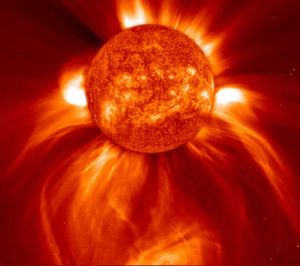It is thought that more than 99.9% of matter in the universe is in plasma” “plasmas are abundant in the universe. More than 99% of all known matter is in the plasma state” “It is an interesting fact that most of the material in the visible universe, as much as 99% according to some estimates, is in the plasma state”
The quote at the bottom from the following link or word button isn't loading right so I recommend clicking Link or word button a couple of lines down:
begin quote from:
99.999% plasma | Plasma-Universe.com
www.plasma-universe.com › 99-999-plasma
People also ask
How much of the matter in the universe is plasma?
99.9 percent
"99.9 percent of the Universe is made up of plasma," says Dr. Dennis Gallagher, a plasma physicist at NASA's Marshall Space Flight Center. "Very little material in space is made of rock like the Earth." The plasma of the magnetosphere has many different levels of temperature and concentration.Sep 7, 1999
Know plasma, know 99.999% of the Universe (No plasma, no Universe)

It is estimated that 99.999% of the visible universe is in the plasma state
99.999% plasma
The visible universe is 99.999% plasma. So quite simply, if you don’t know how plasmas behave, you don’t know how the Universe behaves. It is worth noting that all cosmic plasma carries a magnetic field and electric currents. Even plasmas that are less than 1% ionized, may behave as a plasma, as do dusty plasmas (ie. “dust grains can be the dominant current carrier”)[3].
The Universe is 99.999% plasma
These are quotes from reliable sources:
- “Today it is recognized that 99.999% of all observable matter in the universe is in the plasma state…”[4]
- “It is estimated that as much as 99.9% of the universe is comprised of plasma.”[5]
- “..the plasma state is the most abundant state of matter. It is thought that more than 99.9% of matter in the universe is in plasma”[6]
- “plasmas are abundant in the universe. More than 99% of all known matter is in the plasma state”[7]
- “It is an interesting fact that most of the material in the visible universe, as much as 99% according to some estimates, is in the plasma state”[8]
- “Probably more than 99 percent of visible matter in the universe exist in the plasma state.”[9]
- “It is estimated that more than 99 percent of matter in the universe exists as plasma; examples include stars, nebulae, and interstellar particles”[10]
- “It is sometimes said that more than 99 percent of the material in the universe is in the form of plasma”[11]
- “about 99% of matter in the universe is plasma”[12]
- “99.9 percent of the Universe is made up of plasma,” says Dr. Dennis Gallagher, a plasma physicist at NASA’s Marshall Space Flight Center” [13]
- “How was it determined that 99% of the Universe is in a plasma state? Most of the gas in interstellar space is ionized (astronomers can tell by the wavelengths of light the gas absorbs and emits), and all of the gas in stars in ionized, that’s where the 99% comes from. The 99% ignores any dark matter which might be out there.”[14]
- “It has often been said that 99% of the matter in the universe is in the plasma state.[15]
- “And yet these radio-frequency links must survive the complexities of the plasma which comprises well over 99.9 percent of the universe”.[16]
- “This fourth state of matter probably comprises more than 99.9 per cent of the matter in our Universe.”[17]
- “.. plasmas are so prevalent in astrophysics that Hannes Alfvén (Nobel Laureate 1970) coined the express of a Plasma Universe to express what is really dominant, and it is often said that 99% of the observable universe is in the plasma state.”[18]

The Solar System is 99.85% plasma
The Sun’s mass makes up over 99.85% of the Solar System.[1] , and since it is nearly all in the plasma state,[2] over 99.98% of the mass of the Solar System is in the plasma state
The interplanetary medium is a near-100% plasma
The tenuous matter between the Sun and the planets is a fully ionized (100%) plasma.[19]. While the interplanetary plasma is very thin, it carries both a magnetic field and electric currents estimated at 3×109 amperes (see the heliospheric current sheet).
The interstellar medium is a plasma
The more tenuous matter between stars, the interstellar medium, includes regions of neutral hydrogen gas, dust and plasma such as the “Warm Ionized Medium”, H II regions, and “hot ionized medium”. As a significantly ionized gas, the medium behaves as a plasma, and carries a magnetic field,[20], and electric currents.[21]. (See also dusty plasmas)
The intergalactic medium is a near-100% plasma
The space between galaxies, the intergalactic medium, is a very tenuous, fully ionized plasma. [22], that carries magnetic field and electric currents.[23]
Notes
- ↑ 1.0 1.1 The Solar System edited by Thérèse Encrenaz, Published 2004 Springer, ISBN 3540002413. Page 1ACADEMIC BOOK
- ↑ 2.0 2.1 Introduction to Plasma Physics: With Space and Laboratory Applications, by Donald A. Gurnett, Published 2005 Cambridge University Press, ISBN 0521364833, Page 2ACADEMIC BOOK
- ↑ Cramer, N. F.; Vladimirov, S. V., “Space charge modes in the magnetized discharge with dust”, New Vistas in Dusty Plasmas: Fourth International Conference on the Physics of Dusty Plasmas. AIP Conference Proceedings, Volume 799, pp. 561-564 (2005) (Abstract)
- ↑ Plasma Physics: Proceedings of the 1997 Latin American Workshop : VII LAWPP 97, by Julio Puerta, Pablo Martín, Published 1999 Springer, ISBN 079235527X, Page 57
- ↑ Analytical and Numerical Methods for Wave Propagation in Fluid Media By Krzysztof. Murawski, Published 2002
World Scientific, ISBN 9812381554, Page 14 ACADEMIC BOOK - ↑ Plasma Physics: Basic Theory with Fusion Applications, by Masashiro Wakatani, Kyōji Nishikawa, Published 1994 Springer, ISBN 354065285X, Page 11
- ↑ Basic Space Plasma Physics, by Wolfgang Baumjohann, Rudolf A. Treumann, Published 1996
World Scientific, 1 ACADEMIC BOOK - ↑ Introduction to Plasma Physics: With Space and Laboratory Applications, by Donald A. Gurnett, Published 2005 Cambridge University Press,
ISBN 0521364833, Page 2 ACADEMIC BOOK - ↑ Quantum Statistics of Nonideal Plasmas By Manfred Schlanges, Dietrich Kremp, Wolf-Dietrich Kraeft, Published 2005 Springer, ISBN 3540652841, Page 1 ACADEMIC BOOK
- ↑ Burning Plasma: Bringing a Star to Earth by National Research Council (U.S.), Published 2004 National Academies Press, ISBN 0309090822, Page 188 FULL TEXT ACADEMIC BOOK
- ↑ Plasma Spectroscopy by Takashi Fujimoto, Published 2004 Oxford University Press, ISBN 0198530285, Page 13ACADEMIC BOOK
- ↑ Space Physics: An Introduction to Plasmas and Particles in the Heliosphere and Magnetospheres by May-Britt Kallenrode, Published 2004 Springer, ISBN 3540206175, Page 4ACADEMIC BOOK
- ↑ Dr. Dennis Gallagher, “Plasma, Plasma, Everywhere”, NASA Space Science News {{full}
- ↑ NASA’s Cosmicopia FULL TEXT
- ↑ Francis F. Chen, “Introduction to plasma physics”, Publisher Plenum Press, 1974, ISBN 0306307553, 9780306307553, 329 pages, page 1 ACADEMIC BOOK
- ↑ Banios, E. W., “Plasma Considerations in Space Communications”, IEEE Transactions on Aerospace and Electronic Systems, Nov. 1966, Volume: AES-2, Issue: 6, pages: 333 – 339 PEER REVIEWED
- ↑ Bachynski, M.P., “Plasma Physics – An Elementary Review”, Proceedings of the IRE, (Abs.) Dec. 1961, Volume: 49, Issue: 12, pages: 1751 – 1766
- ↑ Frank Verheest, Waves in Dusty Space Plasmas, Volume 245 of Astrophysics and Space Science Library, Ch. 1 Plasma and Dust, Publ. Springer Science & Business Media, 2012
ISBN 9401099456, 9789401099455. (page 2) ACADEMICBOOK - ↑ Solar wind & interplanetary magnetic field (IMF) FULL TEXT
- ↑ Florinski, V. et al, “On the Possibility of a Strong Magnetic Field in the Local Interstellar Medium”, The Astrophysical Journal, Volume 604, Issue 2, pp. 700-706, (Abstract) PEERREVIEWED
- ↑ Carlqvist, Per, “Cosmic electric currents and the generalized Bennett relation”, Astrophysics and Space Science (ISSN 0004-640X), vol. 144, no. 1-2, May 1988, p. 73-84, (Abstract and full text) FULL TEXT PEER REVIEWED
- ↑ A M Soward, Fluid Dynamics and Dynamos in Astrophysics and Geophysics, Published 2005 Taylor & Francis, ISBN 0849333555. (page 124) ACADEMIC BOOK
- ↑ Jafelice, Luiz C.; Opher, Reuven, “The origin of intergalactic magnetic fields due to extragalactic jets”, Royal Astronomical Society, Monthly Notices (ISSN 0035-8711), vol. 257, no. 1, July 1, 1992, p. 135-151 (Abstract and full text) FULL TEXT
No comments:
Post a Comment